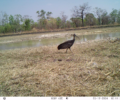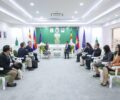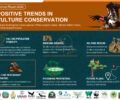Ensuring the dialogue for collaboration from the start is key to success for the Lomphat Wildlife Sanctuary REDD+ Project

On the morning of the 23rd of November, sitting at the back and next to the wall of the kick off workshop to launch REDD+ Project in Lomphat Wildlife Sanctuary (LWS-REDD+ Project), was one participant who was indeed paying close attention to the presentation on introduction to the LWS-REDD+ Project. That person was Mr. Soeung Khemarak, the Director of Lomphat Wildlife Sanctuary in Ratanakiri Province.
Entering the open floor session, he was first to give his input. After hearing in the presentation that the initial assessment conducted by BirdLife International/NatureLife Cambodia reveals that 136,537 hectares of LWS are eligible for REDD+ Project, he quickly sought clarifications about the specifics related to the project area. ‘In the Royal Decree that designated LWS, there is an area of 250,000 hectares. Over 40,000 hectares have been granted to agricultural companies, and around another over 30,000 hectares are earmarked for development. My concern is that the REDD+ project area comes to just over 130,000 hectares. What will happen if, in the future, the Provincial Government requests concessions for land in the protected area for development projects. I would like to ask H.E. Paris do the development projects conflict with our REDD+ Project? Will the Ministry of Environment prioritise the REDD+ Project or the planned development?
Addressing this concern, H.E. Choup Paris, Undersecretary of State, Ministry of Environment and REDD+ Focal Point made it very clear that all areas included in the REDD+ project must be safe from such potential conflicts. Therefore, he suggested that solution would be that National Department of Geographic and Information Service (GIS) of the MoE, the Director of which was also one of the workshop participants, must work closely with the relevant local authorities and LWS management to carefully assess the project area and avoid conflicts.
He also recommended that NatureLife Cambodia (NLC) should play a coordination role to achieve this. Responding to this, Mr. Bou Vorsak, Chief Executive Officers, NLC added that under financial support from USAID Morodok Baitang, there will be series of actions, including stakeholder and village consultations, study visit to previous REDD+ project site and biodiversity and social impact assessments. NLC will ensure that meaningful and comprehensive participation from all related stakeholders is obtained, to assure the project is conducted to the best standards of accountability, accuracy and inclusion.

Later, in the workshops closing remarks, H.E. Chan Ratana, the Deputy Governor of Mondulkiri also addresses this point, expressing his strong support to LWS-REDD+ Project, and requesting that government and planning stakeholders all take an active role in cooperating to secure the project’s success.
The Kick-off workshop was organised to be the first time all the provincial-level government decision-makers had been brought together to discuss precisely these topics. By tackling the more complicated aspects head on at the first opportunity this will provide the basis to bring together the necessary people to navigate the challenges. With these commitments, NatureLife can drive collaboration from related stakeholders including local authorities, communities and MoE and we hope that LWS-REDD+ Project will be developed in a way that will ensure successful implementation.
Tagged:



